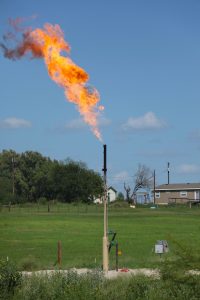 Routine flaring at oil and gas production sites in Texas has been a chronic issue for years, as the rampant process burns off viable fuel product while emitting carbon dioxide, methane and toxic pollutant emissions into the atmosphere. Yet momentum for eliminating the practice is building among investors, operators and landowners, pushing the state’s regulatory body, the Texas Railroad Commission, to consider new flaring policy.
Routine flaring at oil and gas production sites in Texas has been a chronic issue for years, as the rampant process burns off viable fuel product while emitting carbon dioxide, methane and toxic pollutant emissions into the atmosphere. Yet momentum for eliminating the practice is building among investors, operators and landowners, pushing the state’s regulatory body, the Texas Railroad Commission, to consider new flaring policy.
Several major operators, such as Chevron and Pioneer, have already significantly reduced flaring rates to less than 1%. In a recent blog touting Exxon Mobil’s greatly improved Permian flaring performance, the operator stated their experience, “demonstrates that zero routine flaring is within everyone’s reach.”
But as J.P. Morgan Asset Management stated in a recent flaring report, “voluntary operator actions to reduce routine flaring, while necessary, have proven insufficient to deliver on the industry’s full potential,” while reiterating “zero routine flaring by 2025 represents an important and achievable goal.” In order to achieve this goal, policymakers must step in to ensure widespread adoption and outline actionable goals.
Flaring policy blueprint
Any oil and gas company serving the needs of public or private investors understands operational goals are imperative to delivering financial returns and performance updates. Without a concrete target, it can be difficult to stay on track. Flaring performance is no different — flaring goals must be established if the industry wants to eliminate this problem. In addition to clear-cut goals, policymakers should consider several other recommendations for new flaring policy.
Targets: The commission should set interim targets leading up to 2025 to measure success and progress. As other states have done, the targets should include gas capture targets that each company must meet. For example, in 2014 North Dakota set yearly gas capture targets for individual companies that get stricter over time, and New Mexico is also looking at the concept as a part of its comprehensive methane and flaring rules. Concrete targets and goals create accountability, and without them, both industry and regulators have nothing to measure progress against.
A new permit regime and hard stops: Currently, the RRC is allowing operators to flare for 180 days under an “administrative exception.” After 180 days, companies can then apply for a “hearing exception” for additional time to flare — sometimes up to two years and even more. The commission should immediately shorten the amount of time a company is allowed to simply burn away gas under an “administrative exception,” and commit to ending the widespread granting of exceptions obtained through the hearing process. A clear signal needs to be sent that the days of flaring for extended periods of time is over.
Commitment to quality data with accountability: Thus far, the RRC appears to be exploring better use of data, but they need to swiftly move beyond the exploration phase and commit to embracing comprehensive data standards. The data must be accurate and accessible enough for both the public and industry to utilize. Additionally, a robust audit mechanism must be implemented to ensure data accuracy and that operators are complying with existing and/or new rules.
Zero routine flaring by 2025 and the Texas policy needed to get there Share on XImminent policy opportunity
Recent RRC hearings on flaring signal Texas regulators are taking some steps in the right direction, but comprehensive change is needed quickly. Within the past seven years, oil and gas operators in Texas have burned nearly 1 trillion cubic feet of natural gas into the atmosphere. And this isn’t just a waste issue. Three recent studies using aerial survey data of the Permian Basin, the world’s largest oilfield spanning West Texas and New Mexico, have found flare performance there to be abysmal.
Our researchers found 11% of flares surveyed were either malfunctioning — only partially burning the gas — and 5% were completely unlit, venting uncombusted methane straight into the atmosphere. Although the pandemic and economic crisis slowed down flaring this spring, emerging satellite data is showing flaring is on the rebound, with June volume up 50% from May.
Routine flaring is an urgent issue from an operational, financial and environmental standpoint and tolerance for the pervasiveness of the problem is wearing thin from investors, communities and portions of the industry. Zero routine flaring by 2025 is feasible and can be achieved with comprehensive and goal-oriented policy standards.









